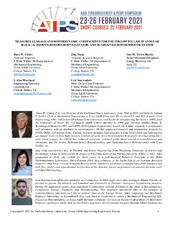| dc.description.abstract | Test results are presented and compared for the following annular pump seal geometries: (a) a smooth-rotor/circumferentially-grooved stator (SR/GS) and (b) a smooth-stator/circumferentially-grooved rotor (GR/SS) The GR/SS seal’s geometry and operating conditions are representative of electrical submersible pumps (ESPs) as used for oil recovery The SR/GS seals’ nominal dimensions are identical with the GR/SS seal except for the reversed groove locations Test results include static and rotordynamic data at speeds ω of 2, 4, 6 krpm for the SR/GS and 2, 4, 6, 8 krpm for the GR/SS seal Both seals have axial pressure drops Δ� of 21, 41, 62, 83 bars, a length-to-diameter ratio �/� of 05, and a minimum radial clearance �� of 203 μm They employ 15 circumferential grooves with a length ��, and depth �� of 152 mm, which are equally spaced with a land length of 152 mm Results are presented for centered conditions Three different inlet-fluid pre-rotation inserts are used upstream of the test seals to create a range of inlet preswirl ratios A Pitot tube is used to measure the circumferential velocity at one location immediately upstream of the test seals The test fluid is ISOVG2 oil @ 46 °CThe GR/SS seal leaks about 10% more than the SR/GS seal Generally, direct stiffness (Kxx, Kyy) values for both designs have low magnitudes that drop with increasing ω The GR/SS seals’ Kxx, Kyy values dropped more rapidly and were negative at 6 krpm For the SR/GS seals, Kyy was negative at 6 krpm, but Kxx was still positive With either design, instability issues are as likely to arise because of negative direct stiffness that pulls down a pump’s critical speed versus directly destabilizing Kxy, Kyx coefficients In the same operating conditions, the Kxy, Kyx coefficients’ magnitudes are ~25 times larger for GR/SS seals than for SR/GS seals --- significantly more destabilizing Under the same conditions, the SR/GS seal has slightly more direct damping than the GR/SS seal Direct virtual mass coefficients are about 20% larger for the SR/GS seals, inducing a lower critical speedWhirl frequency ratio (WFR) combines the effects of the cross-coupled stiffness, direct damping, and cross-coupled mass terms and provides the best measure for comparing the two seal designs’ stability characteristics Overall, the GR/SS seal WFR values are about three times higher than the comparable values for SR/GS seals --- much less stable Effective swirl brakes that could sharply drop the seals’ inlet preswirl would be helpful for the GR/SS seal out to 4 krpm and helpful for the SR/GS seal out to 6 krpm | |


